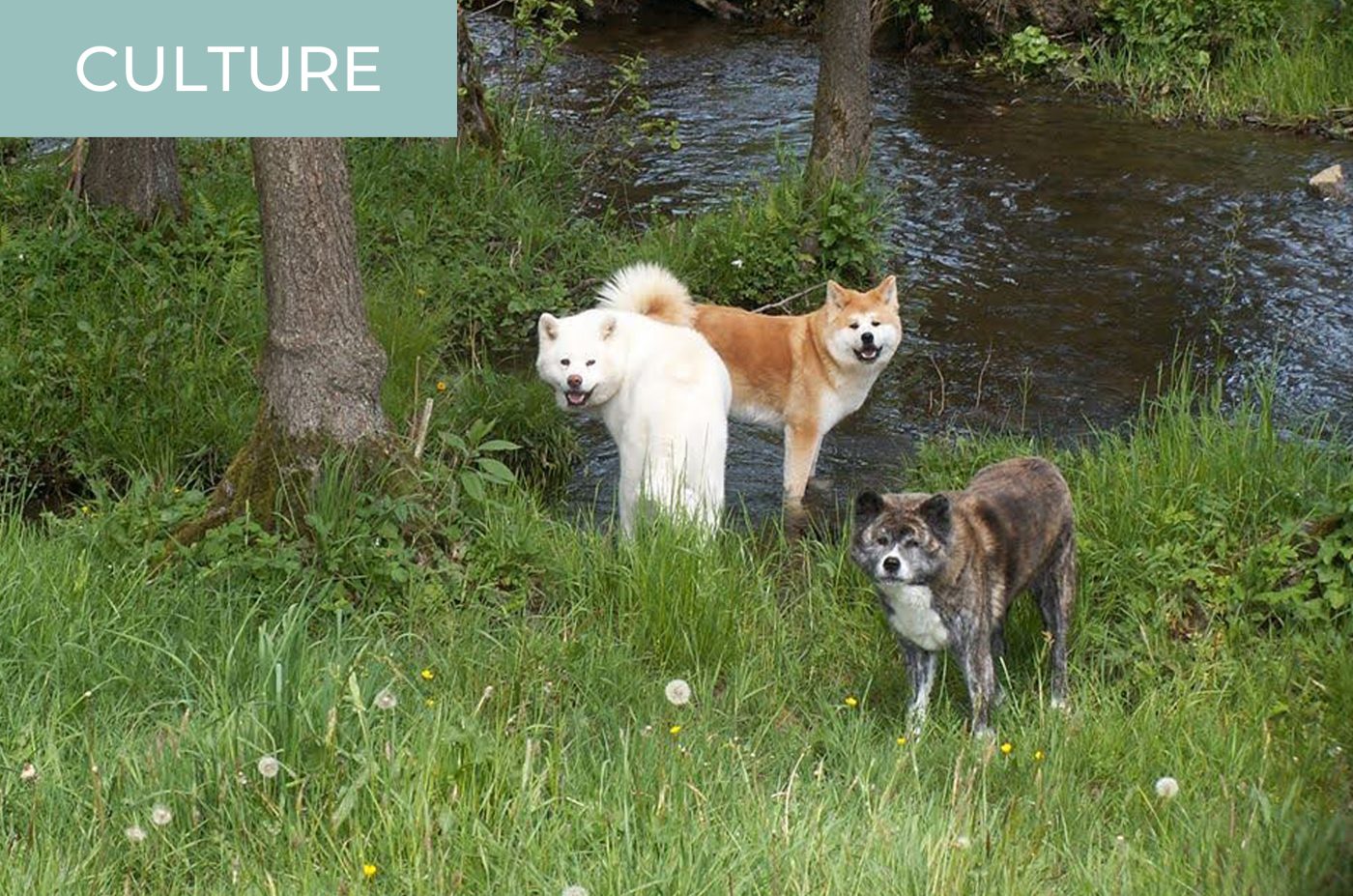Japanese dog breeds such as Akita or Shiba have gained popularity beyond the frontiers of Japan. But did you know some Japanese dog breeds are classified as “Natural Monuments of Japan?”
This article was kindly provided to Kokoro Media by our partner the German-Japanese Association in Munich (Deutsch-Japanische Gesellschaft (DJG) München), and was originally published in the association’s newsletter, Kaiho July/August 2021. Written and translated from German to English by Jeanne-Rose Therre-Ohlig.
Natural Monuments of Japan
Monuments (記 念 物, kinenbutsu) is a collective term used by the Japanese government’s Cultural Property Protection Act. Japan’s cultural properties include historical sites such as shell mounds, ancient tombs, palaces, sites of fortresses or castles, monumental dwellings, and other sites of high historical or scientific value; gardens, bridges, gorges, mountains, and other sites of great scenic beauty; and natural features such as animals, plants and geological or mineral formations of high scientific value. Six of Japan’s dog breeds have been classified as natural monuments in Japan since 1931.
Origins of the Japanese Dog Breeds
The Jōmon period (縄 文 時 代, Jōmon-jidai) is the time in Japanese prehistory, traditionally dated between 14,000-300 BCE. Japan was then inhabited by a diverse hunter-gatherer and early agricultural population united by a common Jōmon culture that achieved a considerable degree of sedentariness and cultural complexity. The Jōmon people are believed to have brought dogs to the Japanese archipelago between 10,000 and 12,000 years ago. The oldest dog skeletal remains discovered in Japan date back 9,500 years before our era. The Jōmon, who lived by hunting and gathering, eventually settled in regions throughout Japan, but mainly on Honshu, with dogs as companions. The Jōmon civilization lasted for almost ten thousand years, from 12,000 to 2,300 BC, and during this time dogs seem to have been the only domesticated animals.
The early Japanese dog was small and about the same size as today’s Shiba. It is generally believed that these early dogs of the Jōmon period are the ancestor of the six Japanese breeds found today and that the prototype of the Japanese breeds was already established in the Jōmon period, followed by the Yayoi period, characterized by fresh wave migrants from the Korean peninsula to Japan.
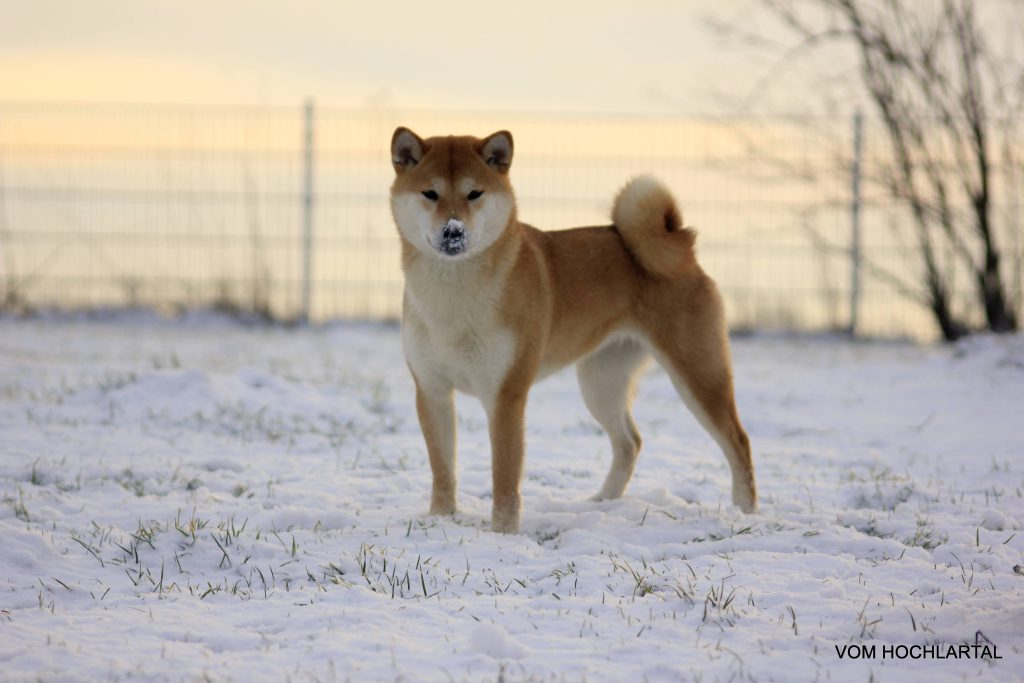
The Yayoi period lasted six hundred years. Skeletal remains of Yayoi period dogs found in the Kuwanae burial mounds in Oita Prefecture and the Yoshinogari burial mounds in Saga Prefecture, both dated to about two thousand years ago, show marked differences from the Jōmon period dogs. They are slightly larger than the earlier dogs and indicate that a new type of dog arrived in Japan in the Yayoi period, along with the new wave of people from the continent.
The care and devotion given to the burial of dogs in Jōmon are no longer evident in sites from the Yayoi period (2300-1700 BC). The remains show cuts and appear to have the flesh torn off. This suggests that dogs were eaten as food in the Yayoi period, and this habit would have been unthinkable among the Jōmon. In the 7th century AD, the “Yamato Court” established a dog guardian office, which helped to preserve native Japanese breeds as an integral part of Japanese culture. In the years following Japan’s opening to the West in 1868, ideas about animal welfare took hold, and all lingering practices of eating dog meat almost completely disappeared.
During the late nineteenth and early twentieth centuries, all kinds of dogs were imported, especially from Europe. In urban areas, crossbreeding between Japanese and foreign breeds proceeded rapidly, while in rural areas from Hokkaido to Kyushu, Japanese native breeds, used mainly by hunters, were protected as indigenous dogs and maintained their genetic integrity. The Japanese Spitz, Chin, Japanese Terrier, and Tosa Fighting Dog are also quite rare but are also still preserved and admired by breeders in Japan and abroad.
Conservation Movement and Designation as a Natural Monument
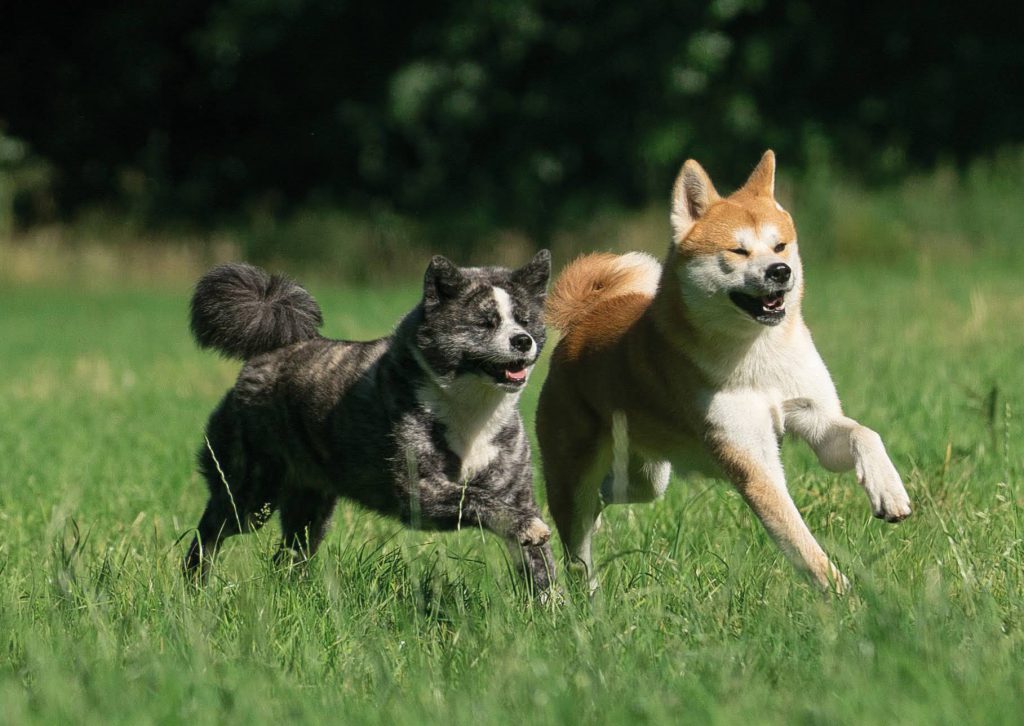
In the second half of the 1920s, the movement to preserve Japanese dog breeds flourished amid growing national interest and pride in Japanese things. Associations were formed and breed standards were formulated to preserve the breeds. The forerunner of the Japan Kennel Club organization, the Japan Guard Dog Association (Zen Nihon Keibi Ken Kyokai), was founded in 1949 for the preservation of Japanese dog breeds. This then became the Japan Kennel Club (Japan Kenneru Kurabu) in 1952. The Japanese name was changed to Japan keneru kurabu (ジャパンケネルクラブ) in 1999. The Nihon Ken Hozonkai (日本犬保存会, Japan Dog Preservation Society), commonly abbreviated as Nippo, is a preserver and keeper of registries for the six native Japanese dog breeds: Akita, Hokkaido, Kai, Kishu, Shiba and Shikoku. Nippo also publishes the Nippo Standard, which serves as the breed standard for the six native breeds.
Nippo was founded in 1928 by Dr. Hirokichi Saito, who served as the group’s first president and was officially designated in 1932. With Nippo’s support, the Akita breed was designated a national monument in 1931, Kishu and Kai breeds in 1934, Shiba breed in 1936, Shikoku and Hokkaido breeds in 1937. Nippo was officially recognized by the Japanese government in 1937. No other country in the world has invested more in the preservation of its dogs than Japan. For the Japanese, their dogs are a source of great pride and respect. Their dogs are their hunters, protectors, and faithful companions. Western influences and war in Japan have almost wiped out the dogs’ breeds. Japanese dog representatives, with the help of the government, have worked tirelessly to bring the breeds to stable numbers. One consolation during these difficult years was the fact that native breeds kept as hunting dogs by hunters in the remote mountain regions of Japan could be used to restore the breeds nationwide.
Famous Akita
Hachikō (ハチ公 or 忠犬ハチ公 chūken Hachikō, the faithful dog Hachikō) saw the light of day on November, 8th 1923 in Ōdate, Akita Prefecture, and moved to Tōkyō in 1924 as the pet of Professor Hidesaburō Ueno of the Imperial University. He got his name from the professor because of the position of his legs, which resembled a Japanese eight 八. Every day, Hachikō would pick up his master from Shibuya station when he came home from work. When the professor died of a brain hemorrhage during a lecture in 1925, Hachikō kept up his habit. Kikuzaburō Kobayashi, the late professor’s former gardener, took over the dog because he lived right near the station.
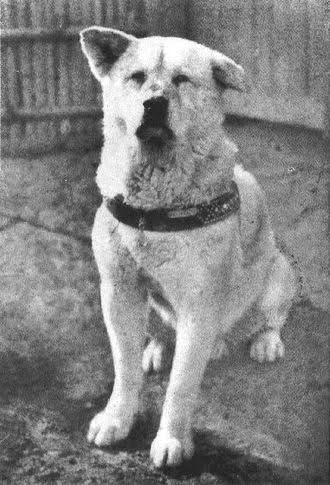
At first, the dog’s presence on the station grounds was not particularly noticed, but in 1928, a new stationmaster made sure that he was given his own place. That year, a former student of Ueno’s, who was researching the Akita breed, realized that Hachikō was one of only 30 remaining members of this breed. In 1932, the dog’s touching story became known throughout Japan after an article about him appeared in a Tōkyō daily newspaper. In 1934, on the very west side of Shibuya Station where Hachikō waited for years, a statue in his honor was unveiled in his presence. On March, 8th 1935, the popular four-legged friend died in Tōkyō at the age of twelve.
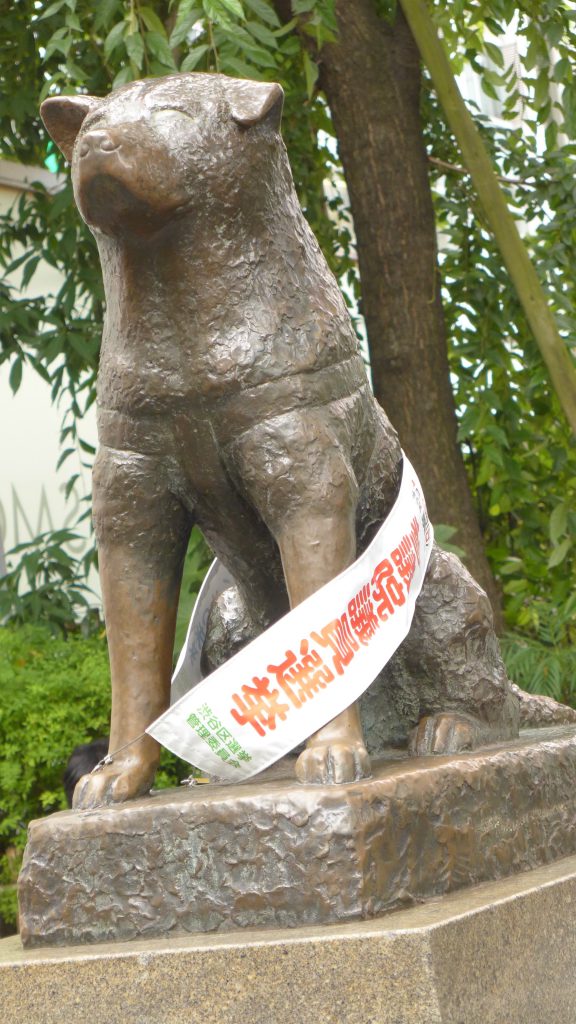
Hachikō’s body was preserved after his death and is still on display at the Tokyo Museum of Nature and Science. During the Second World War, the original statue was melted down for military purposes. After the war, Andō Takeshi, son of the original statue’s creator, who had since died, was commissioned to make a new version, which was erected in its former place in August 1948. Those wishing to visit the statue need only follow the signs for Exit 8 at Shibuya Station. A similar statue stands in Akita Prefecture in front of Ōdate Station, Hachikō’s birthplace. In Japan, Akitas are symbols of good health, happiness, and long life. Friends and acquaintances are given Akita figurines to wish for a speedy recovery.
Film Adaptations and Influence of the Hachikō Story

The film Hachikō Monogatari (ハチ公物語) by director Seijiro Koyama was released in Japan in 1987. In the West, the story became well-known through the 2009 film Hachi: A Dog’s Tale with Richard Gere in an adapted form.
In the manga series One Piece, written and illustrated by manga artist Eiichiro Oda (尾田栄一郎), tribute is paid to Hachikō in the form of the dog Chouchou, who lingers incessantly outside his owner’s shop after his death, guarding it.
In Jurassic Bark, the seventh episode of Futurama‘s fourth season, a lengthy tribute to Hachikō appears. Seymour, the dog of the main character Fry, waits outside the pizzeria where Fry worked for twelve years after his disappearance until he finally passes away.
In the video game, The World Ends with You, Hachikō and the statue erected at Shibuya station play an important role in the narrative. Reference is also made to the associated legend.
In Pokémon: Master Quest, the fifth season of the anime series Pokémon, a similar story exists, according to which the fire Pokémon Vulnona waits 200 years for the return of its owner.
Six Natural Monuments of Japan
Akita
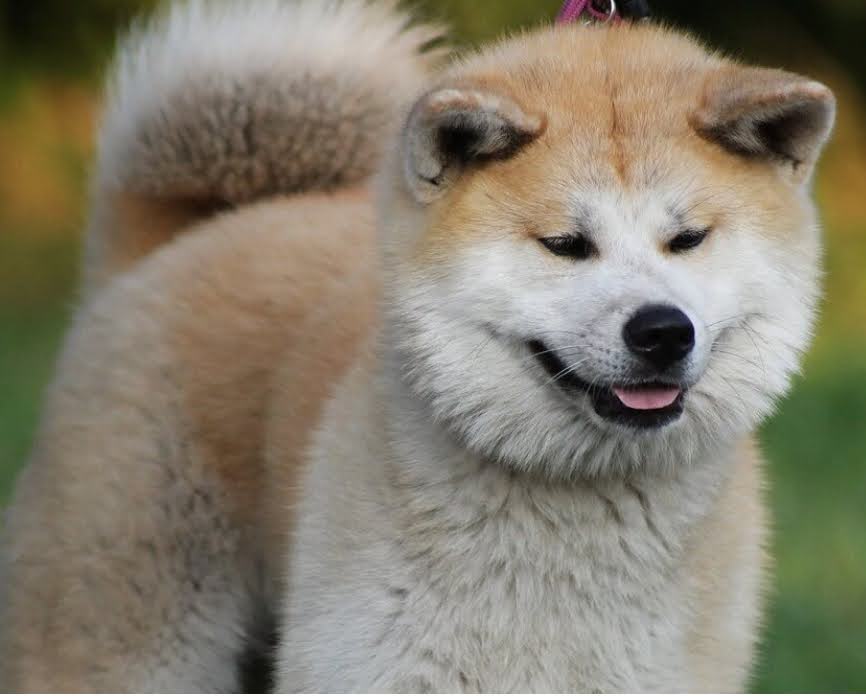
The Akitas (秋田犬) originated in the Akita region of Japan and were originally medium-sized bear-hunting dogs. They were used extensively as fighting dogs because of their size and strength – in the mid-19th century they were crossed with Mastiffs, Tosas and, before the Second World War, with Western dogs, such as the German shepherd (giving rise to the American Akita). In the early 19th century, the Akita is said to have been mainly the companion of the samurai. Akita’s size increased as a result of crossbreeding, but at the cost of losing most of the original Spitz-type characteristics. Due to conservation measures after the Second World War, the Akita today is more like the original type of hunting dog.
The Akita is an independent, self-confident, and reserved dog. He is loyal and protective of his family members. The size and dominance of Akitas make them suitable only for certain dog owners who understand and can handle an Akita. He is one of the most intelligent and independent dogs. He is loyal to his family and has a distant behavior to strangers. He is most comfortable when he is the only dog in the household. The Akita is a strong-willed dog, so it is recommended for dog owners who can take on the role of pack leader. It can only be trained and socialized by loving, firm, patient, and consistent dog owners.
Size: Male (approx. 67cm), female (approx. 61cm),
Life span: 10 to 15 years,
Color: red, brindle, and white (see the main picture for this article)
Hokkaidō
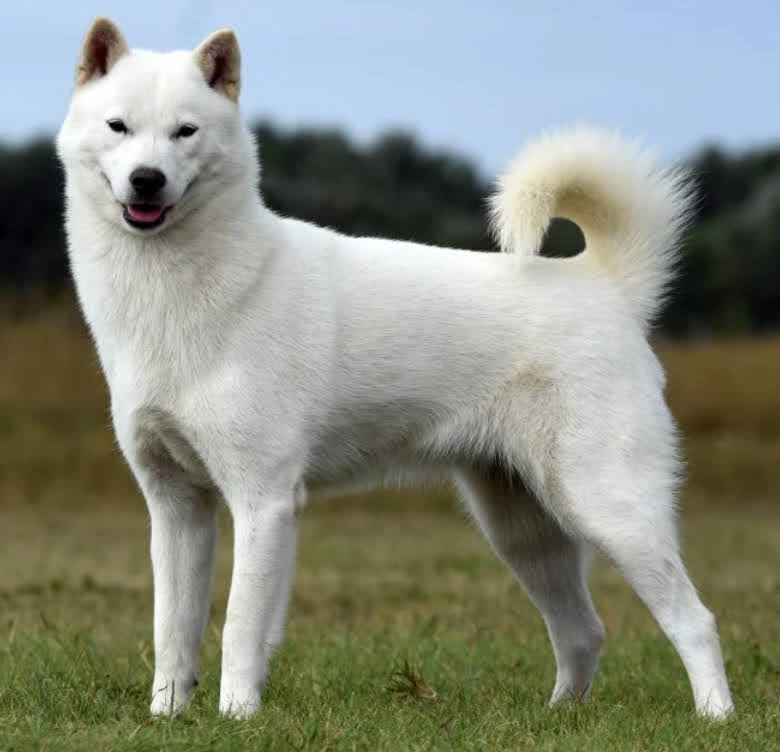
The Hokkaidō dog of the same name is native to the northernmost island of Japan. It probably came to Japan together with one of the indigenous peoples of Japan, the Ainu, during the Jōmon period (approx. 10,000 – 300 BC) and is therefore also called the Ainu dog. The Hokkaidō was bred as a wild hunting dog that could easily handle small bears. The Ainu natives revered their “bear” dogs for their unwavering loyalty, courage, and hunting ability. Long hidden from the rest of the world, this breed of dog was greatly admired and valued for its fearless and aggressive hunting abilities. They are rarely seen outside Japan.
Due to the freezing temperatures in the Hokkaidō region, they have a thicker outer coat and denser undercoat. The harsh environment also allowed them to have larger legs and smaller ears to cope with the snow and freezing cold. In terms of temperament, Hokkaidō is strong-willed, wary of strangers, and sometimes fiery. They are also sensitive dogs. Hokkaidō forges strong bonds with their owners and demands their master’s attention and affection. Although Hokkaidō is not normally a barking dog, he has been known to howl or sing with joy when his owner returns. The breed is an excellent watchdog, faithful, and extremely loyal to its family.
Size: Male (approx. 51 cm), female (approx. 48 cm).
Life span: 12-15 years,
Color: sesame, brindle, red, black, black and tan, white.
Kai
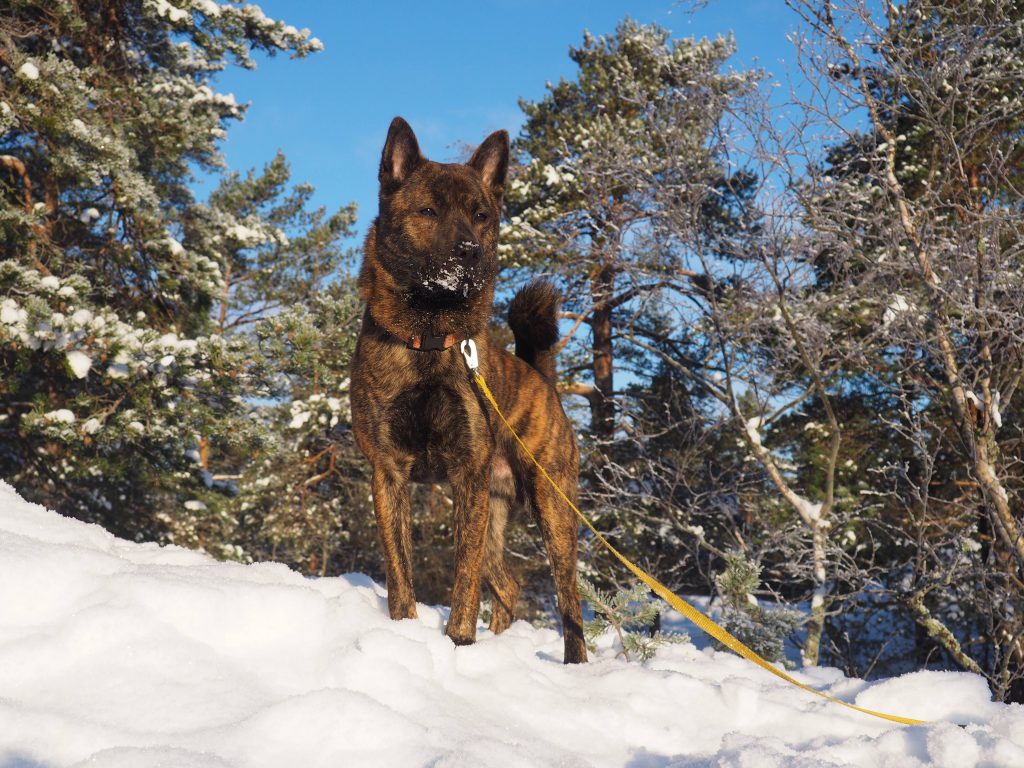
The Kai (甲 斐 犬, also called Tora Inu or Tiger Dog) is a breed that was discovered in 1929 in the mountainous regions of Kai province. Due to the isolated and inaccessible region of its origin, the dog lineage of the Kai has remained virtually intact and pure. Physically, the Kai is very athletic, well-balanced, and solidly built. Its well-developed muscles probably came from living in mountainous and hard-to-reach areas. The Kai Ken was bred to be an excellent hunter of mountain antelope, wild boar, deer, and pheasants. Much of the survival of hunting families depended on the ability of their hunting dogs to track and kill game. Thanks to the protection of the national government and prefectures, the Kai is one of the few indigenous dogs unaffected by the Second World War. The government has even offered tax incentives to owners of kai dogs to protect their national treasures. It is said that a Kai can fight to the death to protect its master. And although a Kai may look fierce, it is said to be very empathetic and sensitive to its master’s feelings. Its hunting instinct has been preserved to this day.
The temperament of a Kai dog is similar to that of other native dogs – independent, loyal – but fierce. The breed is a good watch and hunting dog, he is alert, quick-witted, and ready for action at any time. He gets along well with other animals and with children in the household if you have grown up with him. He needs a dominant and stubborn, pack leader to fit him in.
Size: Male (approx. 53 cm), female (approx. 48 cm).
Life span: 14 -16 years
Color: black, grey tabby
Kishu
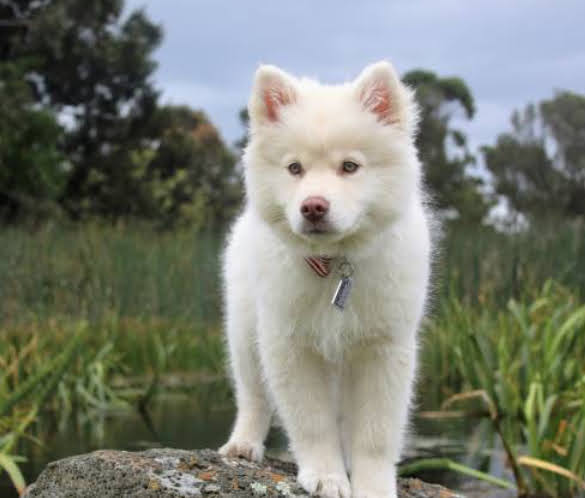
The Kishu (紀州犬, Kishū-Ken) is a relative of the oldest species of pointed dog in Japan, which originated 3000 years ago. It was named after the region of Kishu, now Mie Prefecture and Wakayama Prefecture. It was used for hunting wild boar and deer. This breed is very rare in Japan and in the world.
Despite its hunting abilities, the Kishu feels comfortable lounging in its corner next to its ruler. They tend to seek out a favorite owner and it takes a lot of effort from the other family members to get their attention. They are watchful and protective in nature.
Size: Male (approx. 52 cm), female (approx. 46 cm).
Life span: 11-13 years,
Color: white, brindle sesam
Shiba
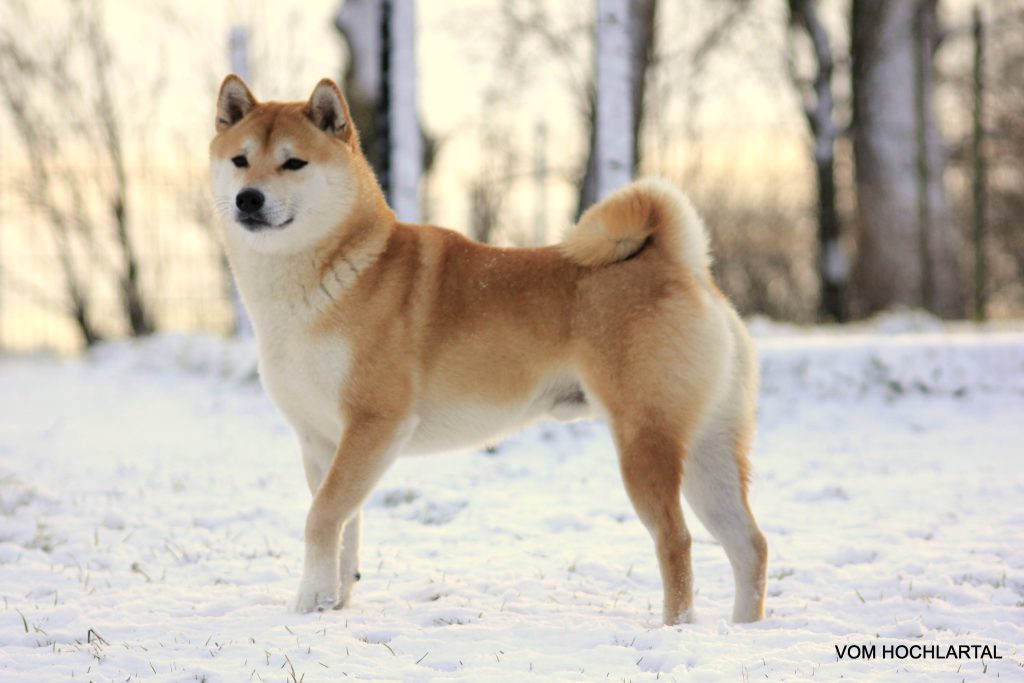
In 300 BC, it was proven that the Japanese already lived with a Shiba (柴犬)-like dog (small stature, curled tail). Primitive drawings from this period show Shiba hunting wild prey. During the Kamakura Shogunate period (1190-1603), samurai used shibas to hunt deer, wild boars, and small game such as birds and rabbits. Shibas lived in the mountainous areas of the Chūbu region (中部地方, Chūbu-chihō).
The Shiba is strong-willed and confident as well as courageous and alert. They are excellent watchdogs. They were prized by hunters for their extreme agility and speed in the enclosure. They can be very territorial and are therefore suitable to be the only pet in the household. Despite their tenacity and willpower, Shibas are affectionate and loyal to their owners.
Size: Male (approx. 40 cm), female (approx. 37 cm).
Life span: 13-15 years
Color: red, black and brown, sesame, black sesame, red sesame
Shikoku
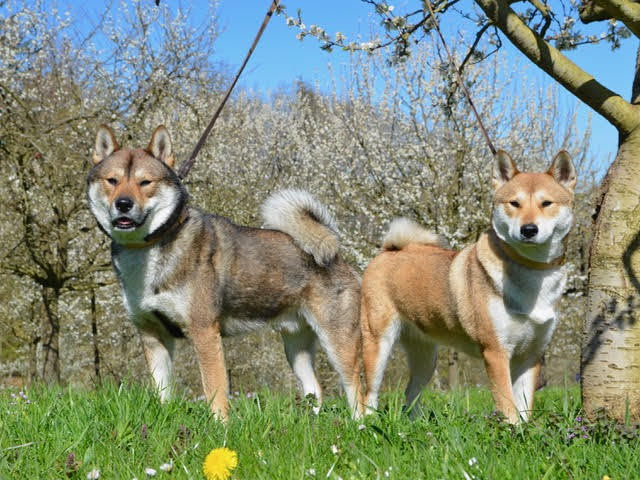
The Shikoku (四国犬, Shikoku-ken) or Kōchi-ken (高知犬) originated on the island of Shikoku. The breed is considered one of the purest due to its geographical situation. Characteristics of this breed are solid-colored puppies that become brindle as they develop. The Shikoku is a very intelligent dog and a quick learner. They are not as stubborn and independent as some of the other native Japanese breeds, but still require patience when training. Shikoku are courageous but cautious and very alert to their surroundings. They are sensitive without being nervous. They are an excellent outdoor companion for active people. They are very energetic and active outside, but inside they are generally calm and quiet.
Size: Male (approx. 50 cm), female (approx. 45 cm +/- 3 cm).
Life span: 10-12 years
Colour: black-tabby, red tabby or brindle
Image Sources
| Akita | Stefanie & Oliver Raspel , Monika Hausner (Akita Club e.v. ) , Antonia Schult, Christiane Lorra, Manuel Kuntz (American Inu), Heike Mewes (Welpe Weiss), Jan Frankenhuizen (American Akita Welpe) | dcnh-ramsraspel[at]web.de, Monika-Hausner-s[at]t-online.de |
| Hokkaidō | Verein Deutscher Club Nordischer Hunde (DCNH), www.chien.com | dcnh-geschaeftstelle[at]t-online.de |
| Kai | Mirka Mertanen, Anniina Virtaten (Welpe Fotografin) | Mirka-mertanen[at]gmail.com |
| Kishu | Verein Deutscher Club Nordischer Hunde (DCNH), www.chien.com | dcnh-geschaeftstelle[at]t-online.de |
| Shiba | Arndt Schmitz | info[at]shiba-hochlar.de |
| Shikoku | Katrin Krüger | katrinkrueger[at]me.com |
We would like to thank the DCNH (Deutscher Club Nordischer Hunde) and the breeders for providing the photos.
Information sources: Heritage of Japan, Monuments of Japan, Wikipedia, VDH, DCNH e.V. (Deutscher Club Nordischer Hunde e.V.) and Breeders

